| 第6回 陶のまち瀬戸のお雛めぐり
<P1> The 6th Moving around Seto City to see Hina Dolls in Girls' Festival season <P1> (Photos taken on Feb. 4 & 12, 2007) |
| 2007年2月2日(金)〜3月4日(日)瀬戸市では市域全域でお雛巡りの為に、 陶製のお雛様などの展示や各種イベントが次のような場所で行われています。 Exhibition of ceramic Hina Dolls and the other events were hold for Girls' Festival Season in the whole area of Seto City for a period of February 2 (Fri.) through March 4 (Sun.), 2007 as follows: ☆ 中心市街地(公的ギャラリー+商店街+私的ギャラリー→約40件)、 ☆ 西部・南部(私的ギャラリー→8件)、 ☆ 赤津地区 (私的ギャラリー→4件;赤津は日本で最も陶芸作家や伝統工芸士 などが密集している地域ですが、今回のお雛巡りに参加している窯元が少ない)、 ☆ 水野地区(私的ギャラリー→6件) ☆ 品野地区(私的ギャラリー→7件;品野陶磁器センターは駐車場1000台) ☆ Downtown area (public gallery + shopping mall + private gallery → about 40 places) ☆ Western and southern area (private gallery → about 8 places) ☆ Akazu area (private gallery → about 4 places; The area seemes to be an area where ceramic artists and traditional craftsmen live in the highest density in Japan. However, only a few potteries participates in this event.) ☆ Mizuno area (private gallery → 6 places) ☆ Shinano area (private gallery → 7 places; "Shinano Ceramic Center" with parking capacity of 1000 cars.) is recommendable) 個人の窯元などでお雛様に関連した作陶体験をお値打ち価格で行える所も多いです。 電話で予約し、一度は体験すると、楽しみ方の幅が増えます。 Pottery forming can be experienced at reasonable prices in many potteries or the other places in relation to Hina Dolls. Reservation by telephone will be needed for the experience in many cases. The experience will enlarge the breadth of how to enjoy. 名鉄瀬戸線の始発駅の「尾張瀬戸駅」に隣接した「パルティせと」、近くの「瀬戸蔵」、 「新世紀工芸館」、「ノベルティ・こども創造館」、「窯垣の小径ギャラリー」、更に 銀座通り商店街や末広町商店街でも様々なイベントが行われています。 Various events are hold at many places such as the following: "Parti Seto" adjoining Owariseto station, starting (terminal) station of private railway line "Meitetsu Seto Line"; "Setogura" citizen center near "Parti Seto"; "Seto Ceramics and Glass Art Center"; "Seto Novelty Children's Creative Center"; "Kamagaki-no-Komichi" museum; Ginza-doori shopping mall, and Suehirocho shopping mall 2月4日と2月12日に市街地の一部を見てきました。以下にその状況の一部を掲載します。 なお、2月18日散策分はページ2を3月3日染付体験はページ3を参照願います。 The atmosphere around downtown, Seto City where I visited on February 4 and 12, 2007 is shown in the following picture. Please see Page 2 for the atmosphere of strolling on February 18, 2007 and page 3 for an experience of painting on ceramic body of one pair of Hina dolls on March 3, 2007. |
| 高さ4mの雛壇に人形約500体が飾られています About 500 ceramic Hina dolls are set up on 4 m-tall tiered stand for dolls. |
 |
| 変わり雛全体 【説明板の説明は注1参照】 <個々の雛は以下の写真参照> All "Kawari-bina" dolls displayed 【See Note 1 for an explanation of the explanation board.】 <See the following photos for each doll.> |
 |
スーパー高三 雛 |
世界一 雛 <第1回WBCで世界一になった 日本チームの王監督とトリノ五輪フィギャ スケートで世界一になったイナバウアを している荒川静香さん> <World's best dolls <Mr. Oh, manager of Japan's team in WBC (World Baseball Classic) and Ms. Shizuka Arakawa, gold medalist in female figure skating at the Turin Olympics 2006. (She is performing a form of "Inabauer".)> |
 |
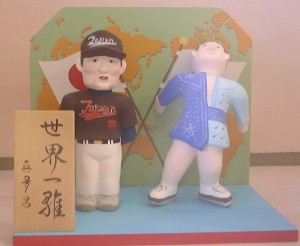 |
| ご慶事 雛 <秋篠宮様と紀子様に 抱かれる悠仁(ひさひと)親王> Auspicious occasion dolls <Akishinonomiya, Imperial Prince Fumihito and Princess Noriko holding their baby, Prince Hisahito in hers arms |
新総裁夫婦雛<21代目総理 大臣安部晋三氏と昭恵夫人> Dolls of couple of new president of LDP <Mr. Shinzo Abe,the 21st president of the Liberal Democratic Party and his wife, Akie> |
 |
 |
| 札幌ドーム・フィーバー 雛 <44年ぶり日本一になった日本ハム ファイターズの新庄選手と 上機嫌の高橋はるみ道知事> Sapporo Dome Spree Dolls <Nippon Ham Fighters has won the national championship for the first time in 44 years. Mr. Shinjo, the team player and Ms. Harumi Takahashi, Governor of Hokkaido> |
県庁裏金 雛 Prefectural government illicit money dolls |
 |
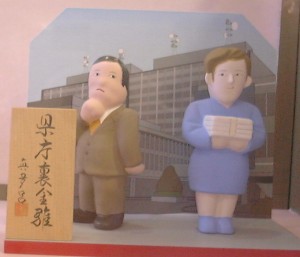 |
| 瀬戸蔵 <2月3(土)〜4日(日) 瀬戸染付絵付体験 参加費1500円 (送料は別)> "Setogura" <Feb. 3 (Sat.) - 4 (Sun) Painting experience on ceramic body for "Seto-Sometsuke-Yaki" ware Entry fee Yen1500 (excluding Shipping charges)> |
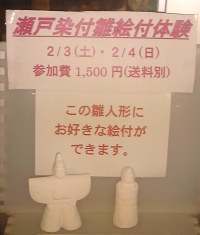 |
| 雛人形1対の陶器の素地に好きな絵付けをすると、後日、焼いて送ってもらえます。 <絵付体験者が絵付けした作品です。小さく見えますが、高さは12cm位あります。> Participants paint their own favorite image on a pair of ceramic body for "Seto-Sometsuke-Yaki" ware. After that, the painted body will be fired and sent. <Photos show the works painted by the participants. The works looks small, but the height is about 12 cm.> |
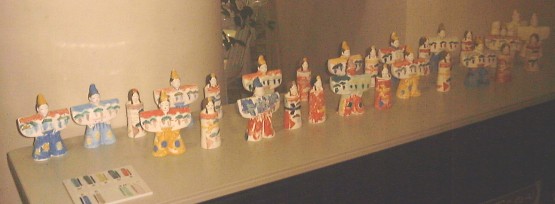 |
| 蔵遊前の玄関 <奥にお雛様が飾られています> Entrance of Gallery & Cafe "Kurayuzen" <Hina dolls are displayed in the back > |
 |
| 「窯のひろば」に展示されている大正〜昭和初期の「御殿飾り」 <右が中京風(下の写真参照)、左が関東風> "Palace-like dolls decoration" from Taisho era (1912-1926) to early Showa era (1926-1989) <Chukyo-style (at right), Kanto-style (at left)> |
 |
| 中京風の「御殿飾り」(関東風は少ししか映っていません) Chukyo-style "Palace-like dolls decoration" <Only a few of Kanto-style one is shown > |
 |
| 古民家久米邸 雛壇 <玄関入った母屋;下の写真参照> Old private house Kume House - Tiered stand for dolls <at room of main house in front of the entrance; See photo below.> |
 |
| 母屋の雛壇(左) Tiered stand for dolls of main house (left) |
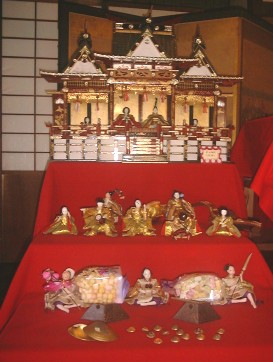 |
| 母屋の雛壇(右) Tiered stand for dolls of main house (right) |
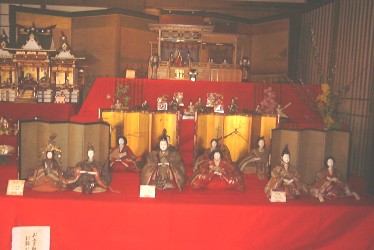 |
| 雛壇<米俵が興味をそそります;母屋の北側の部屋> *巻物ではなくて米俵でした Tiered stand for dolls <Rice bale is interesting.; Room at north of main house> * Cylindrical substance is rice bale, not scroll. |
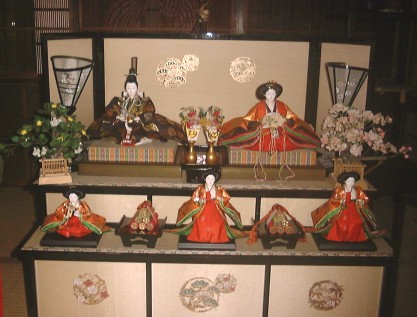 |
| 古民家久米邸のお蔵(現在はギャラリー)の2階 に展示してある雛壇 Tiered stand for dolls exhibited at 2nd floor of a warehouse of the Kume House (The warehouse is gallery at present) |
 |
| 古民家久米邸のお蔵(現在はギャラリー)の2階 に展示してある雛壇 Tiered stand for dolls exhibited at 2nd floor of a warehouse of the Kume House (The warehouse is gallery at present) |
 |
| 「パルティせと」1階の雛壇<左右のズームアップは下の写真参照> Tiered stand for dolls exhibited at the first floor of "Parti Seto" < See pictures below for the zoom in.> |
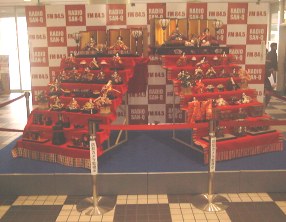 |
| 左の雛壇 Left tiered stand for dolls |
右の雛壇 Right Tiered stand for dolls |
 |
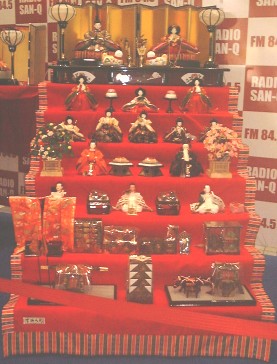 |
| 末広町商店街の「末広ギャラリーピーコック」の雛壇 Tiered stand for dolls at "Suehiro Gallery Peacock" in Suehirocho shopping mall |
 |
| 【注1-
説明板の説明の一部】 ☆変わり雛とは 大正時代末期から昭和初期にかけて、東京を中心とした・・・文人・画家・工芸作家などが、 ・・・ひとつのグループを作り・・・ある年、その年の干支にちなんで様々な素材を用いて 雛人形を作り、お互いに交換し合うことにした。・・・ふたつ並べて雛人形に見立て、 これを「見立て雛」と呼んだ。・・・「変わり雛」の原点。 ・・・中心的立場にいた人形師 初代金林真多呂は終戦と同時に・・・テーマを干支でなく、その時代の流行・時の話題・ 社会風刺などに求め「変わり雛」として販売した。 現在は、肖像権・著作権などの問題もあり、販売は一切していない・・・。 制作の基本コンセプトとしては・・・・男女一対の人形でつくり・・・。 ☆変わり雛の素材・制作工程など ・・・桐の木を細かく粉状にしたものと糊を混ぜて粘土状にしたもの・・・。その素材で 作ったものを乾燥後、絵の具で彩色したもので、人物の顔などはあまりそっくりに 出来ない場合もあり、その辺が制作の難しいとろとなっています。 【Note 1 - Part of explanation in the explanation board】 ☆ What is "Kawari-bina" doll? "Kawari-bina" means unique Hina dolls. Tokyo-based - - - litterateur, artist, crafter - - - from the end of Taisho era (1912-1926) to early Showa era (1926-1989)- - - formed a group - - - made Hina dolls at a year, using various materials derived from Oriental Zodiac of the year and exchanged each other. - - - laid two dolls out in a line, used the two dolls to resemble Hina dolls and called the dolls as "Mitate-bina". - - - "Mitate-bina" is basis of "Kawari-bina". - - - at the same time with the end of World War II, puppeteer, the first Kanabayashi Kitamaro who was in main position - - -Seeking and setting the theme as contemporary fashion, topic and social satire, he sold the Hina dolls as "Kawari-bina". The "Kawari-bina" dolls are not sold today due to right of publicity or copyright . - - - under the basic concept for producing the dolls - - - a pair of male and female dolls is made - - -. ☆ Material and producing process, etc. - - - material is in clayey state by mixing paulownia tree made powdery finely with glue - - - A work is completed by drying and coloring the semi-finished work made by the material. Recent situation will not allow face of a work to be just like the real one. So, such situation should be considered in producing work. |